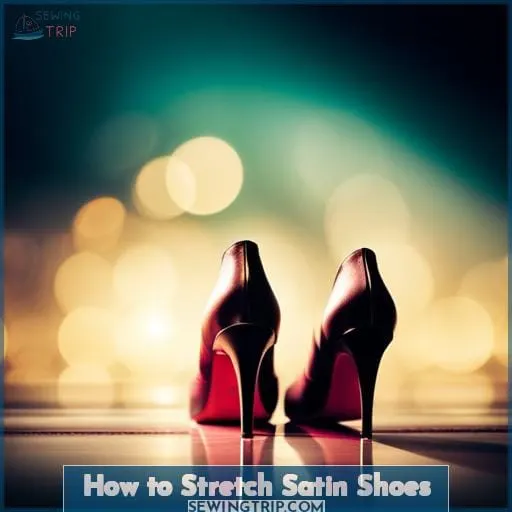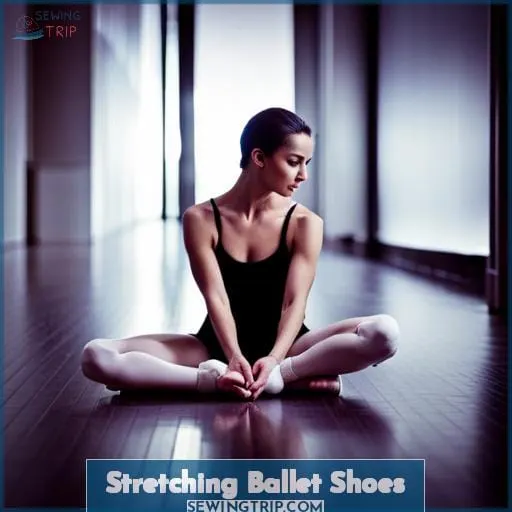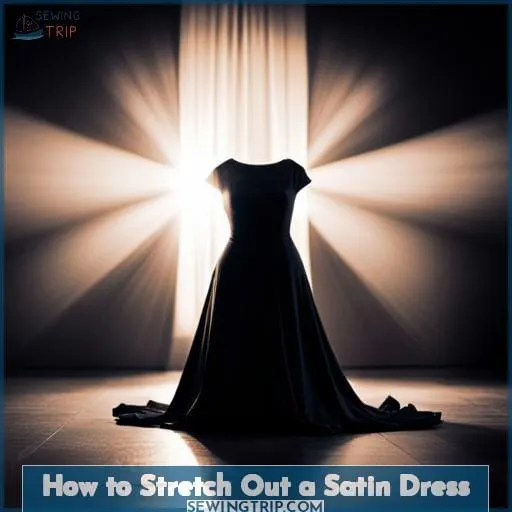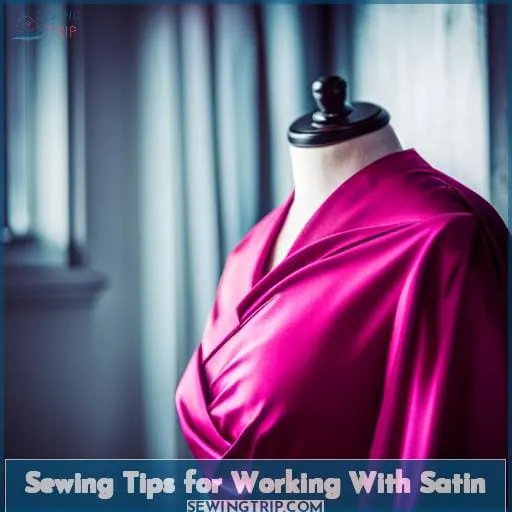This site is supported by our readers. We may earn a commission, at no cost to you, if you purchase through links.
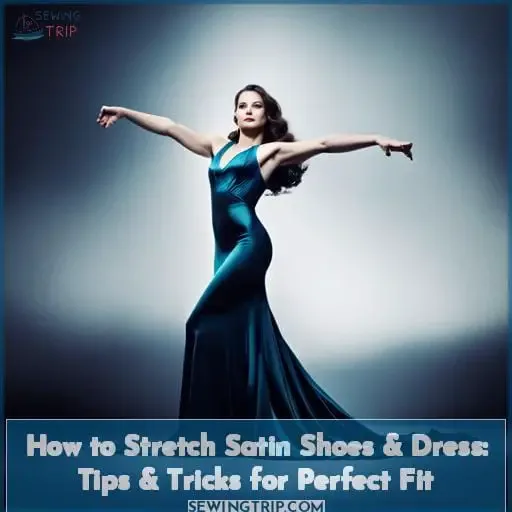 Struggling with a satin dress or shoes that just don’t fit? Don’t despair! You may be able to stretch them out, making them the perfect size – and you can do it yourself. We’ll show you how to stretch satin shoes and dresses so they fit like a glove, no matter what type of fabric you’re dealing with.
Struggling with a satin dress or shoes that just don’t fit? Don’t despair! You may be able to stretch them out, making them the perfect size – and you can do it yourself. We’ll show you how to stretch satin shoes and dresses so they fit like a glove, no matter what type of fabric you’re dealing with.
From twilled satin to antique and crepe back styles, we’ve got some tricks up our sleeve for stretching out your clothes without ruining their shape or texture.
Table Of Contents
- Key Takeaways
- Is Satin Stretchable?
- Can Satin Be Stretchy?
- What is Stretch Satin Fabric?
- Does Twilled Satin Stretch?
- Can You Stretch Satin Shoes?
- How to Stretch Satin Shoes
- Stretching Ballet Shoes
- How to Stretch Out a Satin Dress
- Different Types of Satin
- Sewing Tips for Working With Satin
- Frequently Asked Questions (FAQs)
- Conclusion
Key Takeaways
- Stretching a satin dress is not recommended as it can damage the seams and stitches.
- Satin fabric has a tendency to fray easily, so caution is needed when working with it.
- Different types of satin have different stretching capabilities, with some offering more elasticity than others.
- Proper storage and sharp scissors are essential when working with satin to prevent damage and achieve a clean finish.
Is Satin Stretchable?
You can’t give your old satin dress a new lease on life by simply pulling it taut – different fabrics may offer varying levels of flexibility. Satin, in particular, is known for its luxurious drape and finish but what about the stretch benefits? It’s important to know if this fabric is an option when you’re looking for something that offers just enough give.
The answer lies in the type of satin you choose. Pure silk or other fibers will not easily stretch, while blended with spandex gives around 15%. Twill satin fabric has some ability to move but generally rates low on stretching capabilities compared with others like polysatin – made from nylon and spandex which provides more elasticity.
When it comes to caring for your clothing items crafted from this beautiful material, keep in mind how delicate it can be when stretched too far; water stains could occur, so use caution during any attempt at making them bigger than they are already! As well, sewing challenges arise due to difficult cutting—it tends to fray quickly, so sharp scissors must be used along with consistent cuts throughout the project’s construction process—but there are many tutorials available online if unsure about tackling such projects alone.
Buying quality materials should always lead off any list before attempting specific designs: make sure all pieces come together nicely without having been overstretched first because once ruined no amount of tugging will bring back its original form again! In short: If seeking extra roominess, opt out going down a size instead since trying one’s luck at stretching satins could leave behind unexpected results later on down the line.
Can Satin Be Stretchy?
Discover if the fabric you’re considering has enough give to ensure a comfortable fit – some, like Spandex-blended Satin, provide up to 15% elasticity.
There are several types of satin available on the market; antique, charmeuse, and crepe back satin all offer an elegant drape while Duchess and slipper satins bring extra comfort with their softness. Each type should be considered before purchasing as they vary in stretching capabilities.
Twill is rated low for its ability to stretch but may still be suitable depending on your needs!
When it comes time for cutting or stretching these fabrics at home, proper storage solutions must first be addressed: keep them away from direct sunlight or damp areas which could damage material integrity over time.
For those looking into techniques such as how best to stretch shoes made from this luxurious fabric—specialized professionals may have unique tools capable of doing just that safely without compromising quality standards elsewhere within design elements (e.
g., seams). However, some DIY options exist including using water-based solutions or even wearing them around during housework activities until the desired size is achieved! Ballet slippers can similarly benefit from hairdryers set at the lowest temperatures when needing quick fixes here too…just avoid working directly onto delicate materials unless absolutely necessary since any permanent marks would otherwise remain after the drying process is completely finished up afterwards.
Stretching a dress, however, is not recommended due to the potential of ruining seams/stitches involved—so always opt out going down one size instead if seeking more roominess than the current piece provides already without risking complete disaster later down the line either way! All told, then understand what each style offers in terms of both flexibility & aesthetics together before making the final decision today – because finding the perfect fit starts by understanding the difference between all fabrics available now, something sure worth exploring further ahead well indeed…
What is Stretch Satin Fabric?
Experimenting with the varying elasticity of different satin fabrics can lead to finding a comfortable and stylish fit. Satin is one type of material that offers a lot of stretch, but not all varieties provide enough for every occasion.
To ensure you are working with the right stretch material, it’s important to consider both your needs and the fabric’s ability before purchasing. For example, Spandex-blended Satin provides up to 15% elasticity while Twill is rated low in its stretching capabilities.
When sewing or cutting at home, proper storage solutions should be addressed first as this fabric quickly frays. Sharp scissors are essential, along with consistent cuts throughout construction projects using tailor’s chalk marks as guides.
If wondering how best to stretch shoes made from satin, then specialized professionals may have unique tools capable of doing this safely without compromising quality elsewhere within design elements (e.
Stretching dresses, however, isn’t recommended due to the potential for ruining stitches/seams. So always opt for going down one size instead if needing more roominess than the current piece already provides, without risking a complete disaster later on either way.
Understand what each style offers in terms of flexibility and aesthetics together before making a final decision today because the perfect fit starts by understanding the difference between all materials available.
Does Twilled Satin Stretch?
Twill Satin can be likened to a rubber band, as it has very little give when stretched. It is made of two different yarns that run perpendicular to each other in the weaving process, which gives it its signature diagonal patterning and texture.
The type of weave used determines the amount of stretch that will be possible. Messaline-made twill satin tends to hold up better than others but still does not provide much elasticity.
When attempting stretching techniques with this fabric type, caution should be taken as overstretching could cause fraying or water stains.
When considering how best to achieve desired results from twilled satin garments without damaging them in any way – whether shoes or clothing items – professional assistance may prove invaluable here too.
Though use of water by itself isn’t recommended either since there’s a higher risk associated with this method overall. With proper care given during handling processes, however, most pieces maintain their shape quite well even after multiple washes/wearings are done.
In short, depending on your needs at hand, always keep fabric types top priority before doing anything else—for a truly perfect fit every single time no matter what kind you’re looking for today!
Can You Stretch Satin Shoes?
Moving on from twill satin, let’s take a look at the stretching potential of satin shoes. Satin can be quite tricky to stretch, as this go-to material for many fashion statements is not very elastic and has limits when it comes to how far it can be stretched without damaging its integrity.
To avoid any mishaps when attempting DIY methods at home, calling in professional help is always best and should guarantee success. Heat solutions with thick socks or other pieces of equipment are also popular choices for those looking to get their perfect fit.
While sewing tips remain important no matter what fabric type you choose, such as using sharp scissors and testing with muslin first, they become even more crucial if you’re dealing with something like satin.
Satin is difficult to cut, frays easily under pressure, and is unforgiving of mistakes all around! So ensure your seams stay intact by double-checking every step during the production process before committing anything permanently.
All told then, although professionals usually provide better results than attempts made alone, ultimately only patience combined with caution will lead one towards achieving desired results within reasonable boundaries set by the limitations imposed upon us by our fabric’s stretch capabilities.
How to Stretch Satin Shoes
If you’re looking for a way to stretch out your satin shoes or dress, it can be done without having to buy a new pair. Professional stretching is the best option, as they’ll be able to accurately judge just how much the material can handle and get you that perfect fit.
Alternatively, there are home solutions available such as using thick socks with heat treatments, which should also provide some relief from an ill-fitting shoe/dress.
Professional Stretching
If you’re looking to get the perfect fit for your satin shoes, calling in a professional is like getting a tailor-made suit – they can help ensure your look fits comfortably. Professionals use techniques that focus on stretching methods such as heat or pressure applied with thick socks or other pieces of equipment.
They also use tailor’s chalk for precise measurements. When it comes to fabric choice, experts will also assess seam preservation during production by using cutting tools that are sharp enough not to fray edges easily.
They may also use baking soda solutions when needed. Dress designers recommend avoiding stretching at home altogether due to potential water stains caused by wet cloths used in DIY methods, which could ruin the item irreversibly! Investing time into finding an experienced specialist may just prove invaluable when it comes to protecting those beautiful garments made from expensive materials like satin.
Home Stretching Solutions
You can attempt to stretch your satin shoes at home using stretching solutions tailored for the material. Heat application is recommended when dealing with this delicate fabric. Use a hairdryer on a low setting or warm cloths that are not overly wet.
Tailor’s chalk and sharp scissors also come in handy when making cuts as they prevent fraying of already cut edges.
To avoid shrinking later on, it’s best to keep an eye out for any signs of water damage while sewing patterns and taking measurements with the chalk marks previously made. Nice drape is key! Additionally, make sure all materials used do not have too high of a shrink factor before you start cutting away as mistakes may prove costly further down the production line.
Stretching Ballet Shoes
If you’re looking to stretch out your satin ballet shoes, there are a few methods you can try. Wearing the shoes while doing housework is one effective way of stretching them, as long-term use will naturally expand the fabric and make for a comfortable fit.
Alternatively, using a hairdryer on a low heat setting over the area that needs extra room can also help loosen up any tightness in the material.
Wearing During Housework
Wearing your ballet shoes while doing housework can help give them the extra bit of room they need. Taking a few necessary precautions like wearing socks, applying heat using a steam iron or fabric softener, and avoiding stretching tools will ensure that you don’t damage the delicate satin fabric.
For those looking for an easier option, professional shoe stretchers are also available. When working with satin garments to customize their fit, be sure to use tailor’s chalk to mark where changes should be made.
In addition, when shopping around, remember that slipper satin is an excellent choice as it has more stretch than other varieties such as antique or charmeuse fabrics, which may not provide enough flexibility in movement.
Using a Hairdryer
A hairdryer can quickly and easily provide a custom fit for your ballet shoes! Using heat is one of the best stretching options available when dealing with delicate fabrics like satin. Opting for higher quality fabric to begin with also helps ensure that you won’t damage the seams or suffer from water stains after using a hairdryer.
For athletic shoes, keep in mind that slipper satin has long held its reputation as an excellent choice due to its impressive stretchability. This type of fabric gets its name from the French word ‘chaussons’, meaning ‘shoes’.
How to Stretch Out a Satin Dress
Stretching a satin dress isn’t advised because it could ruin the seams and stitches, so take caution when trying to get that perfect fit. Sewing with satin can be difficult due to its reputation for fraying easily and being notoriously hard to cut.
To make sure you avoid these risks, be sure to store your fabric in plastic bags away from sunlight or moisture until ready for use.
Different styles of satin also require different approaches. Antique or charmeuse may need more attention while crepe back or duchess might have an easier time accommodating clothing items like dresses without becoming stretched too far out of shape.
Keep in mind that each type of fabric has unique needs which must be taken into consideration when sewing projects using them.
Different Types of Satin
If you’re looking to make a statement with your outfit, adding some satin fabric can be the perfect touch. There are several different types of satin available, each with their own unique properties and uses.
Antique Satin is typically used for upholstery, while Charmeuse offers a lightweight feel that works great for both evening wear and lingerie.
Crepe Back Satin has more texture than other varieties, while Duchess Satin provides the extra weight needed in formal gowns or bridal attire.
With the right knowledge of these fabrics’ characteristics, you’ll be able to create beautiful clothing items from any type of satin!
Antique Satin
Discover the unique texture of antique satin and create timeless pieces that will never go out of style! When choosing satin for a project, consider its reputation for fraying easily. Ironing advice is important as well when working with this fabric. Sewing techniques must be precise to avoid cutting problems or fraying issues.
Take a little time in the beginning to ensure you get fabrics out of your way without a main issue later on.
Charmeuse Satin
Charmeuse satin is an ideal fabric for creating elegant outfits with a luxurious feel and look. Its softness allows for stretching, making it suitable for garments that require shaping or tailoring. When washing charmeuse, use cool water and delicate detergent to avoid damage from too much heat or harsh chemicals.
Selecting the right charmeuse requires careful consideration of its weight as well as fiber content when cutting and pressing it.
Crepe Back Satin
Experience the softness and beauty of crepe back satin, perfect for creating delightful garments that flatter your figure. Stretching techniques can add a unique dimension to any garment without compromising quality or durability.
Cutting tips help avoid fraying issues; storage solutions ensure consistency in cuts, and unforgiving mistakes are easily avoided with care.
Duchess Satin
Let yourself be carried away by the exquisite softness and elegance of Duchess Satin – perfect for creating garments that will make you look and feel your best. Properly storing it, sharpening scissors, testing muslin fabric, and avoiding frays are key to consistent cuts.
Slipper Satin
Indulge in the sleek and sophisticated touch of Slipper Satin – perfect for crafting a look that will make you stand out from the crowd. To ensure success, store properly, sharpen scissors, test with muslin fabric, and avoid frays and mistakes.
Sewing Tips for Working With Satin
Discover the tips and tricks for working with satin fabric to create garments that look polished and professional, while avoiding common mistakes. Whether you’re making a dress, shoes, or upholstery, there are certain techniques you should follow when sewing satin material.
Sharpening your scissors is an essential step since dull blades will cause fraying of the fabric’s delicate fibers. Additionally, it helps to test your pattern pieces on muslin first to ensure accuracy before cutting into expensive fabrics like duchess or crepe back satins.
Consistent cuts also help reduce any unwanted frays along seams by keeping all edges even throughout each project piece.
With these simple steps in mind, you’ll be able to work with this tricky material without worry so that every garment looks perfect after completion!
Frequently Asked Questions (FAQs)
Is it possible to stretch a satin dress without ruining the seams and stitches?
Stretching a satin dress is similar to attempting to fit an octopus into a box: it can be accomplished, but it requires extreme caution. Achieving this without damaging the seams and stitches necessitates patience and precision, much like the process of painting the Sistine Chapel.
By executing the task carefully, you can stretch your satin dress without compromising its integrity.
Is it safe to stretch satin shoes at home?
Yes, it is safe to stretch satin shoes at home. However, caution should be taken to avoid overstretching or water stains when doing so. Professional stretching may be the best option for ensuring a proper fit and avoiding any damage.
Are there any special scissors needed for cutting satin fabric?
When cutting satin fabric, sharp scissors are essential to achieve a clean and professional finish. Look for ones with micro-serrated blades for precise cuts and an alligator handle design that gives you more control while avoiding fatigue.
Are there any special techniques for sewing with satin?
Sewing with satin requires sharp scissors, consistent cuts, and testing with muslin.
What is the difference between charmeuse and crepe back satin?
Don’t be overwhelmed! Charmeuse and crepe back satin are both luxurious fabrics. The main difference lies in their texture: charmeuse has a smooth, shiny surface, while crepe back satin has a textured reverse side.
Conclusion
In conclusion, satin is a delicate fabric that can be tricky to work with. However, when stretched correctly, it can be used to create beautiful clothing. With proper storage, testing, and sharp scissors, sewing with satin can be a rewarding experience.
Have you ever wondered what it would be like to sew with satin? With the right knowledge and techniques, you can create a masterpiece with this luxurious fabric.






